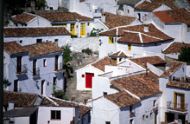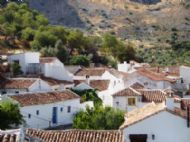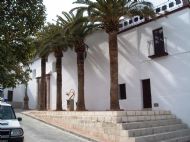Montejaque ~
Present & Past
Entering the village through Avenida Andalucia you will find your self in the newer p[art where you will encounter some of the local shops, then, on continuing straight up the main street bast the bakery, you will eventually reach square (plaza). It is around the main streets and squares that you will find all the local facilities.:- shops, banks, pharmacy, bakery, tapas bars and resturants.
As in all the 'pueblos blancos', Montejaque dates from the time of the Berber settlers after the conquest of the Moors. Approximately 700meters above sea-leavel it is located in a semi-hidden bowl, concealed by circular rocky outcrops, it overlooks a small fertile valley of olive groves.
 The Plaza is dominated by the Parish Church of Santiago El Mayor which originally was built on the foundations of a mosque. In 1604 the chgurch was remodeled by Don Pedro Diaz de Palacios (the architect of Malaga Cathedral), it was once again enlarged and re-dedicated in 1773. It is now an example of the Late Gothic style, having a large centeral nave and a vaulted roof covering the presbytery.
The Plaza is dominated by the Parish Church of Santiago El Mayor which originally was built on the foundations of a mosque. In 1604 the chgurch was remodeled by Don Pedro Diaz de Palacios (the architect of Malaga Cathedral), it was once again enlarged and re-dedicated in 1773. It is now an example of the Late Gothic style, having a large centeral nave and a vaulted roof covering the presbytery.
 Also in the Plaza is the old noble mansion house, which today is the hotel Palacete de Marara. During the 17th century, this mansion was the seat of power for the Conde de Benavente and was used when he visited his domain to collect taxes and hunt on the then wooded mountain slopes. The family arms, carved in sandstone, can still be seen above the main door of the building. The house was to see sadder times in the first half of the last century, when it became a sausage factory! This closed in 1955 due to changing EU legislation. Happily at the end of 1998, it was converted into a hotel, with a very good restaurant.
Also in the Plaza is the old noble mansion house, which today is the hotel Palacete de Marara. During the 17th century, this mansion was the seat of power for the Conde de Benavente and was used when he visited his domain to collect taxes and hunt on the then wooded mountain slopes. The family arms, carved in sandstone, can still be seen above the main door of the building. The house was to see sadder times in the first half of the last century, when it became a sausage factory! This closed in 1955 due to changing EU legislation. Happily at the end of 1998, it was converted into a hotel, with a very good restaurant.
 The third large building in the Plaza, the Casa de Constitution (Town Hall) which was rebuilt in the present style after the Civil War.
The third large building in the Plaza, the Casa de Constitution (Town Hall) which was rebuilt in the present style after the Civil War.
Many, many years ago a Castillo (Castle) was located tn the area beyond the plaza, However, it was destroyed after the re-conquest and many of the surviving walls were remodeled into homes. It is within this historic area tha Casa Santa Maria is located.
From the valley below the village, the old medieval road to Ronda zigzags’ over the limestone outcrop. This track is still used today and passes the Hermita de las Escariguelas, visited during the fiesta every May by a procession of villagers carrying a statue of the pueblo’s patron saint, the Virgin de la Conception; not an easy task as the path climbs steeply more than 300 feet. Beyond the hermita, the path continues and provides a panoramic view of Ronda in the distance.
 Casa Santa Maria | sitemap | log in
Casa Santa Maria | sitemap | log in
 Casa Santa Maria | sitemap | log in
Casa Santa Maria | sitemap | log in